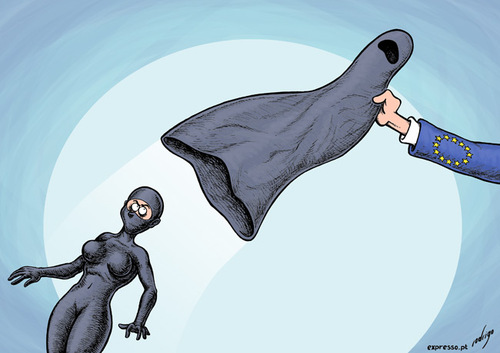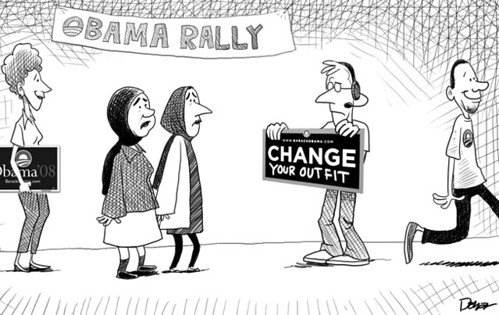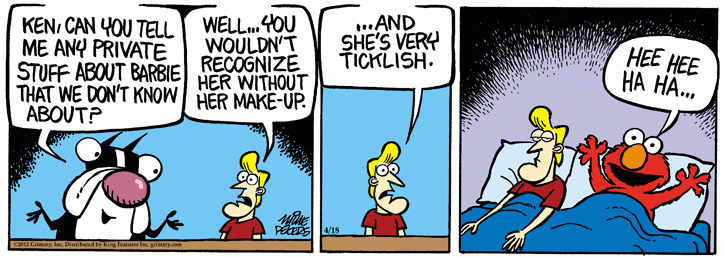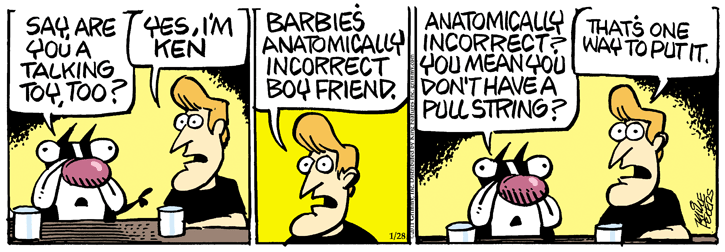Gender?
Monday, July 23, 2012
Anything you can do I can do...but for less.
It's shocking that in today's society there are still cases of the gender wage gap. But after reading this article about Maine where women working full time are paid 22 percent less. Women working right next to their male counterparts, working the same tasks, but not making the same amount seems to be one of the most disappointing things. We've come such great lengths in gender equality, but this is truly unacceptable. It has even hit close to home, when I discovered that at my own place of employment there is gender inequality. Not on the sales floor, but for our dock associates, responsible for loads and unloading our new stock, men and women are paid differently and are assigned different tasks suiting their traditional gender roles. It just astounds me that these differences still exist. If you are going to hire somebody for a certain position then they should be allowed to work all the tasks involved and for equal pay.
TO VEIL OR NOT TO VEIL? A Case Study of Identity Negotiation Among Muslim Women in Austin, Texas
In the article, "TO VEIL OR NOT TO VEIL? A Case Study of Identity Negotiation Among Muslim Women in Austin, Texas" by Jen'nan Ghazal Read and John P. Bartkowski, the negative stereotype attributed to Muslim women is addressed.
The assumption that veiled Muslim women are dressed that way against their will, implies their willingness to yield freedoms and rights.
Religious preference. Veiled women are considered more devout followers of their religion than those who choose the "freedom" to not be veiled. The women who choose to veil consider themselves pious and devoted to their god, Allah, thereby making them obedient Muslim women. In addition to the concept of religious practice, another justification for this practice is the argument that you can't be tempted by what you don't see. Out of sight, out of mind. By veiling, sexual temptation is skewed, with the possible prevention of potential, negative consequences (i.e., unwanted pregnancy, rape, undesired sexual advances, etc.). Additionally, some of the women who choose to don the veil notice increased respect and lack of unwanted sexual advances from members of the opposite sex.
Although I could understand the liberation of not wearing the veil, (as if to be rebellious, or to enjoy freedom from the constraints of religion), I can also understand the importance of religious devotion by wearing the veil, and the benefits of avoiding unwanted sexual advances. This article helped open my eyes to the different aspects that I hadn't considered, with regards to the practice of Muslim women to be veiled or not to be veiled.

http://y1mia.blog.sbc.edu/files/2011/10/clothing-and-oppression.jpg

http://y1mia.blog.sbc.edu/files/2011/09/burqa.jpg

http://www.cbc.ca/gfx/images/news/photos/2010/03/12/cartoon-aislin-cp.jpg

http://www.courrierinternational.com/files/illustrations/article/2009/07/BurqaBabes/1.jpg

http://static.guim.co.uk/sys-images/Guardian/Pix/cartoons/2010/4/23/1272035980275/Salma-Yaqoob-001.jpg

http://www.toonpool.com/user/1631/files/the_cultural_veil_913085.jpg

http://ginacobb.typepad.com/gina_cobb/images/2007/04/06/pelosi_in_hijab_2.jpg

http://farm4.static.flickr.com/3170/2592507719_0026fb7581.jpg

http://www.islamophobiatoday.com/wp-content/uploads/2012/02/article-0-1192BD1E000005DC-743_306x787.jpg
The assumption that veiled Muslim women are dressed that way against their will, implies their willingness to yield freedoms and rights.
Religious preference. Veiled women are considered more devout followers of their religion than those who choose the "freedom" to not be veiled. The women who choose to veil consider themselves pious and devoted to their god, Allah, thereby making them obedient Muslim women. In addition to the concept of religious practice, another justification for this practice is the argument that you can't be tempted by what you don't see. Out of sight, out of mind. By veiling, sexual temptation is skewed, with the possible prevention of potential, negative consequences (i.e., unwanted pregnancy, rape, undesired sexual advances, etc.). Additionally, some of the women who choose to don the veil notice increased respect and lack of unwanted sexual advances from members of the opposite sex.
Although I could understand the liberation of not wearing the veil, (as if to be rebellious, or to enjoy freedom from the constraints of religion), I can also understand the importance of religious devotion by wearing the veil, and the benefits of avoiding unwanted sexual advances. This article helped open my eyes to the different aspects that I hadn't considered, with regards to the practice of Muslim women to be veiled or not to be veiled.

http://y1mia.blog.sbc.edu/files/2011/10/clothing-and-oppression.jpg

http://y1mia.blog.sbc.edu/files/2011/09/burqa.jpg

http://www.cbc.ca/gfx/images/news/photos/2010/03/12/cartoon-aislin-cp.jpg

http://www.courrierinternational.com/files/illustrations/article/2009/07/BurqaBabes/1.jpg

http://static.guim.co.uk/sys-images/Guardian/Pix/cartoons/2010/4/23/1272035980275/Salma-Yaqoob-001.jpg

http://www.toonpool.com/user/1631/files/the_cultural_veil_913085.jpg

http://ginacobb.typepad.com/gina_cobb/images/2007/04/06/pelosi_in_hijab_2.jpg

http://farm4.static.flickr.com/3170/2592507719_0026fb7581.jpg

http://www.islamophobiatoday.com/wp-content/uploads/2012/02/article-0-1192BD1E000005DC-743_306x787.jpg
Post-Princess Models of Gender: The New Man in Disney/Pixar
In Ken Gillam and Shannon R. Wooden's article, "Post-Princess Models of Gender: The New Man in Disney/Pixar," the role(s) of male figures is/has been making adjustments. The idea that the lead male role requirements include overt masculinity, dry tear ducts, and emotional vacancy, is not as celebrated as it once was. Instead, emergence and development of a male's ability to "get in touch with his feminine side" appears to take precedence over traditional male characteristics. The competence of a male is in direct proportion to his ability and willingness to discuss his feelings and emotions.
"The New Man" acquires strength by recognizing, acknowledging, and understanding his own shortcomings. An example of dependence on others' skills to survive and escape danger, is given regarding the character, Mr. Incredible, from the movie, The Incredibles (2004). "Mr. Incredible likewise must embrace his own dependence...Mr. Incredible needs women--his wife's superpowers and Mirage's guilty intervention--to escape." (Gillam and Wooden, 2008)
The article points out that movies are progressively leaning towards bringing sociological education to audiences, as well as entertainment. History has shown that entertainment reflects the values of society at that time, including society's changing views and definitions of what it means to be masculine/feminine.

http://www.cartoonstock.com/newscartoons/cartoonists/efi/lowres/efin2244l.jpg

http://static.andertoons.com/img/toons/cartoon1809t.png
"The New Man" acquires strength by recognizing, acknowledging, and understanding his own shortcomings. An example of dependence on others' skills to survive and escape danger, is given regarding the character, Mr. Incredible, from the movie, The Incredibles (2004). "Mr. Incredible likewise must embrace his own dependence...Mr. Incredible needs women--his wife's superpowers and Mirage's guilty intervention--to escape." (Gillam and Wooden, 2008)
The article points out that movies are progressively leaning towards bringing sociological education to audiences, as well as entertainment. History has shown that entertainment reflects the values of society at that time, including society's changing views and definitions of what it means to be masculine/feminine.

http://www.cartoonstock.com/newscartoons/cartoonists/efi/lowres/efin2244l.jpg

http://static.andertoons.com/img/toons/cartoon1809t.png
Lesbian is terrorized and tortured
This CNN article describes a hate crime that took place in Lincoln, Nebraska. Three men bound a woman and carved cruel words into her skin. The men also painted a slang/derogatory term for lesbians inside the woman's home and proceeded to torch the home with gasoline. The woman escaped and made it to her neighbor's home. When her neighbor answered the door, she was shocked to see the woman, naked, sobbing, covered in blood, and bound at the wrists. Her neighbor made the call to 911 to report what had happened. Members of the LGTB (lesbian, gay, bisexual, and transgendered community) organized a meeting to raise awareness, and a tremendous amount of people showed to show their support of LGTB. Lincoln strives to fight for justice in hopes that the community will come together and make sure similar situations like this do not occur. The battered woman is known throughout her neighborhood for mowing the lawns, raking leaves, and shoveling snow for others in the neighborhood. She also apologized to her neighbor for waking her stepson on the night she showed up at her doorstep. Situations like this are just devastating. I don't understand how people can justify terrorizing another human being on the basis of their sexual preference. Who cares if this woman wants to date other women?! It has absolutely no effect on any bystander. This woman is apparently extremely caring and giving and probably has ten times a bigger heart than anyone who discriminates against her. I admire the Lincoln community for coming together to make sure that justice is done. My condolences and prayers go out to the victim and anyone else who suffers from similar persecution.
http://www.cnn.com/2012/07/23/justice/nebraska-hate-crime/index.html
http://www.cnn.com/2012/07/23/justice/nebraska-hate-crime/index.html
Klaus Barbie, and Other Dolls I'd Like to See
In Susan Jane Gilman's article, "Klaus Barbie, and Other Dolls I'd Like to See", consumer culture is portrayed as a system in which to fit in, you must look a certain way. The Barbie doll image is upheld, and any diversion from the "torpedo-titted, open-mouthed, tippy-toed" (Gilman 1998) example is considered unworthy in the eyes of society. If you don't look like Barbie, you don't look "right". Visual aesthetics, not substance, is rewarded in social settings. Barbie is the exception, not the norm. Gilman offers suggestions with regards to realistic-looking dolls that are more reflective of today's culture. Her examples include Blue Collar Barbie (equipped with traditional factory worker accessories, in addition to other outfits available, to represent the 2nd job, in order to make ends meet), and Our Barbies, Ourselves (which comes complete with anatomical correctness, for educational purposes, as well as other "accessories").
As Gilman states in her article, "..somewhere along the line, we stop believing in our own beauty and its dominion. Subsequently, we also stop believing in the power of our minds and our bodies."

http://www.cartoonstock.com/lowres/rjo0924l.jpg

http://www.cartoonstock.com/lowres/dca0254l.jpg

http://www.cartoonstock.com/lowres/wwe0636l.jpg

http://www.grimmy.com/images/MGG_Archive/MGG_2012/MGG-2012-04-18.gif

http://www.grimmy.com/images/MGG_Archive/MGG_2011/MGG-2011-01-28.gif

http://www.cartoonstock.com/newscartoons/cartoonists/tmc/lowres/tmcn1913l.jpg

http://www.cartoonstock.com/lowres/dca0192l.jpg
As Gilman states in her article, "..somewhere along the line, we stop believing in our own beauty and its dominion. Subsequently, we also stop believing in the power of our minds and our bodies."

http://www.cartoonstock.com/lowres/rjo0924l.jpg

http://www.cartoonstock.com/lowres/dca0254l.jpg

http://www.cartoonstock.com/lowres/wwe0636l.jpg

http://www.grimmy.com/images/MGG_Archive/MGG_2012/MGG-2012-04-18.gif

http://www.grimmy.com/images/MGG_Archive/MGG_2011/MGG-2011-01-28.gif

http://www.cartoonstock.com/newscartoons/cartoonists/tmc/lowres/tmcn1913l.jpg

http://www.cartoonstock.com/lowres/dca0192l.jpg
Growing Up in the Culture of Slenderness: Girls' Experiences of Body Dissatisfaction
In Sarah Grogan and Nicola Wainwright's article, "Growing Up in the Culture of Slenderness: Girls' Experiences of Body Dissatisfaction" (from Women's Studies International Forum 19, no.6 (1996): 665-673), interviews were conducted with participants of two age groups, 8-year-old girls and 13-year-old girls. They were asked questions about their satisfaction regarding their body images. Although the 13-year-olds didn't like the skinniness of the models in a magazine, they were jealous of their skinny friends. (Grogan and Wainwright, 1996.) The self-consciousness associated with the unrealistic expectation(s) for women to be skinny, brings about negative and unreachable goals. These warped images are exposed to girls in the media, thereby starting at an early (pre-adolescent) age the unrealistic idea that to be beautiful, a female must be skinny. These delusions are the epitome of eating disorders such as anorexia nervosa and bulimia. Other consequences include psychological disorders resulting from dissatisfaction with body shape/size, as well as poor self image. Psychological issues are not the only consequences. Physical health, including medical concerns, is jeopardized by the lack of important nutrients essential for good health. This is especially true for not only young, developing girls, but also for women, including those who are pregnant. Unfortunately, because our society is one in which beauty is dictated by outside imagery, the health of young girls is in danger.

http://www.cartoonstock.com/lowres/wda0787l.jpg

http://www.cartoonstock.com/lowres/dca0123l.jpg

http://www.cartoonstock.com/newscartoons/cartoonists/cwl/lowres/cwln561l.jpg

http://www.cartoonstock.com/newscartoons/cartoonists/pto/lowres/pton201l.jpg

http://www.cartoonstock.com/lowres/epl0283l.jpg

http://www.cartoonstock.com/newscartoons/cartoonists/rba/lowres/rban132l.jpg

http://www.cartoonstock.com/lowres/ear0922l.jpg

http://assets.amuniversal.com/5f7b0f60e175012e2fb000163e41dd5b

http://www.cartoonstock.com/lowres/ren0018l.jpg

http://www.cartoonstock.com/newscartoons/cartoonists/mba/lowres/mban2454l.jpg

http://www.cartoonstock.com/lowres/epa2058l.jpg

http://www.cartoonstock.com/lowres/ang0196l.jpg

http://www.cartoonstock.com/lowres/dca0230l.jpg

http://www.cartoonstock.com/lowres/wda0787l.jpg

http://www.cartoonstock.com/lowres/dca0123l.jpg

http://www.cartoonstock.com/newscartoons/cartoonists/cwl/lowres/cwln561l.jpg

http://www.cartoonstock.com/newscartoons/cartoonists/pto/lowres/pton201l.jpg

http://www.cartoonstock.com/lowres/epl0283l.jpg

http://www.cartoonstock.com/newscartoons/cartoonists/rba/lowres/rban132l.jpg

http://www.cartoonstock.com/lowres/ear0922l.jpg

http://assets.amuniversal.com/5f7b0f60e175012e2fb000163e41dd5b

http://www.cartoonstock.com/lowres/ren0018l.jpg

http://www.cartoonstock.com/newscartoons/cartoonists/mba/lowres/mban2454l.jpg

http://www.cartoonstock.com/lowres/epa2058l.jpg

http://www.cartoonstock.com/lowres/ang0196l.jpg

http://www.cartoonstock.com/lowres/dca0230l.jpg
Wars, Wimps, and Women: Talking Gender and Thinking War
In Carol Cohn's article, "Wars, Wimps, and Women: Talking Gender and Thinking War", she talks about the differences between discourse of men and women. In a game simulated to portray the realities of war, Cohn was placed on a team who ultimately decided to pull its troops out of Afghanistan, based on careful reasoning, strategy, and morality. In the end, Cohn's team was defeated by another team who used who violent and aggressive war tactics. A member of another team mentioned that he saw weakness in Cohn's team when they decided to pull their troops out, and thus, knew he could walk all over them and push them around. This member of the other team continued on to say that after his team militantly nuked Cohn's team and they didn't retaliate, he knew that they were just wimps, so they continued to nuke Cohn612). The aggressive and violent tactics carried out by the opposing team silenced the tactics that were based upon logic and reason, on the foundation that they were "insufficiently masculine". (Cohn 613). Cohn states, "You learn that someone is being a wimp if he perceives an international crisis as very dangerous and urges caution; if he thinks it might not be important to have just as many weapons that are just as big as the other guy's; if he suggests that an attack should not necessarily be answered by an even more destructive counterattack; or, until recently, if he suggested that making unilateral arms reductions might be useful for our own security. All of these are 'wimping out' "(Cohn 613). Upon reading this, I really got to thinking about our government and its decisions in the ongoing war in the middle east that was heightened by the 9/11 terrorist attacks. Is our government simply retaliating with weapons and firearms on the basis that it is what is considered to be masculine, and therefore, acceptable? Are logic, reason, and morality tossed aside because these qualities give off a "wimpy" representation? When and where do we draw the line between proving masculinity and doing what is right on behalf of our country?
https://bblearn.missouri.edu/bbcswebdav/pid-775810-dt-content-rid-13853305_1/courses/sociology_3320_av/Cohn%20-%20Wars%2C%20Wimps%2C%20and%20Women%20-%20Talking%20Gender%20and%20Thinking%20War.pdf
https://bblearn.missouri.edu/bbcswebdav/pid-775810-dt-content-rid-13853305_1/courses/sociology_3320_av/Cohn%20-%20Wars%2C%20Wimps%2C%20and%20Women%20-%20Talking%20Gender%20and%20Thinking%20War.pdf
Subscribe to:
Posts (Atom)